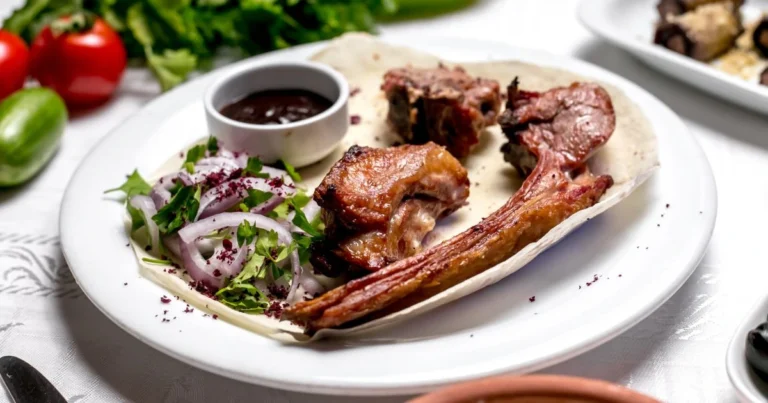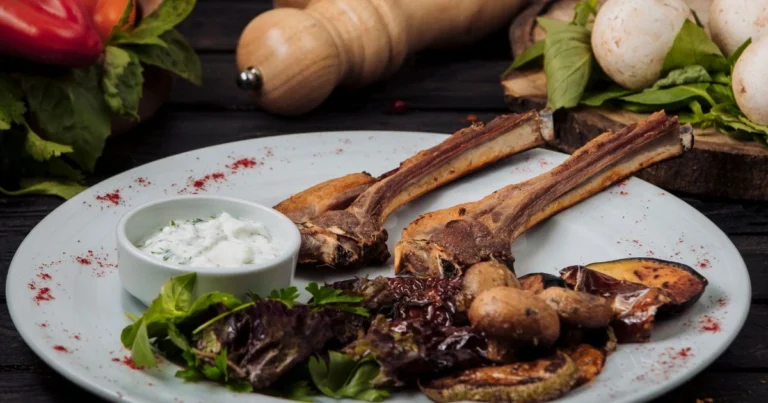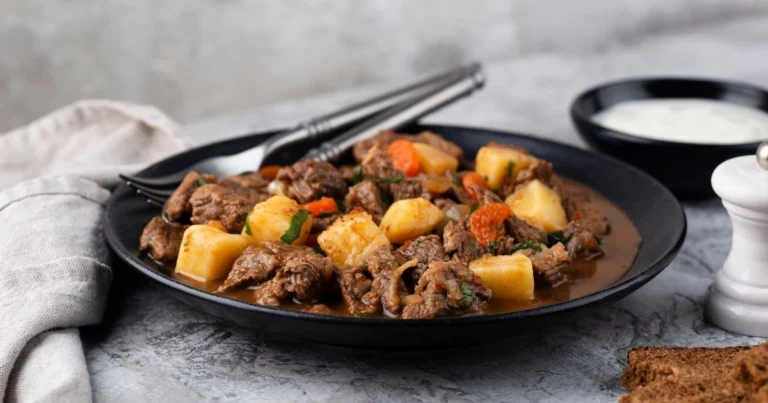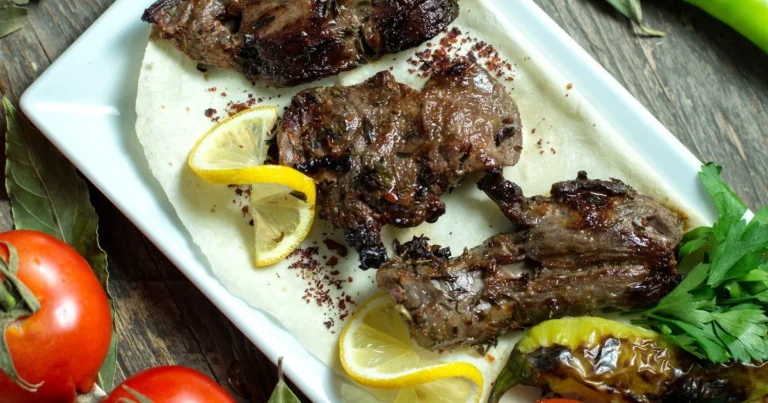Tender Lamb Breast Plate Recipe: A Flavorful Meal
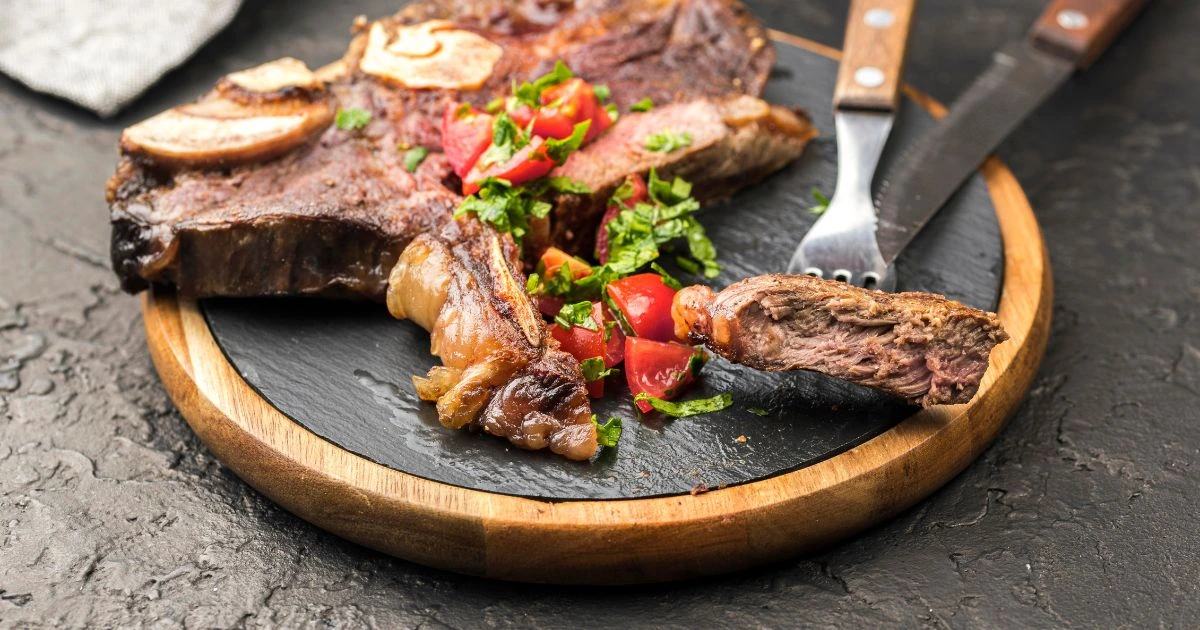
Every home cook dreams of making a meal that turns a simple dinner into a special event. The lamb breast plate recipe is a perfect choice. It offers a mix of flavors and textures that will make your cooking stand out and impress your guests.
Cooking lamb might seem scary, but it’s actually a hidden treasure in cooking. Lamb breast plate is prized for its rich flavor and melt-in-your-mouth tenderness—perfect for seasoned chefs and adventurous home cooks alike.
The lamb breast plate is more than just a meal. It’s a celebration of cooking skills. Learning how to cook this cut will change how you approach lamb. It will also make your meals unforgettable.
Table of Contents
Understanding Lamb Breast: A Premium Cut
Exploring gourmet lamb dishes starts with knowing lamb breast cut. This meat offers a rich taste and tender texture. It’s perfect for those who love deep flavors.
Lamb breast is known for its rich taste and tender texture. It’s a favorite among chefs and home cooks. They love how it turns into delicious meals with the right cooking.
Exploring Lamb Breast Varieties
There are different types of lamb breast cuts. Each offers a unique cooking experience. Here are the main ones:
- Split lamb breast plate
- Boneless lamb breast
- Whole lamb breast with ribs
- Trimmed lamb breast sections
Fat Content and Meat Quality
Lamb breast has a lot of fat, which makes it taste amazing. When cooked, this fat melts, making the meat tender and juicy.
Nutritional Insights
Lamb breast is both delicious and rich in nutrients. A serving gives you:
- High-quality protein
- Essential B vitamins
- Important minerals like zinc and iron
- Moderate fat content
When picking lamb breast for your dishes, choose cuts with good marbling and a fresh color. This ensures a memorable meal that showcases the meat’s natural qualities.
Essential Ingredients for Perfect Lamb Breast
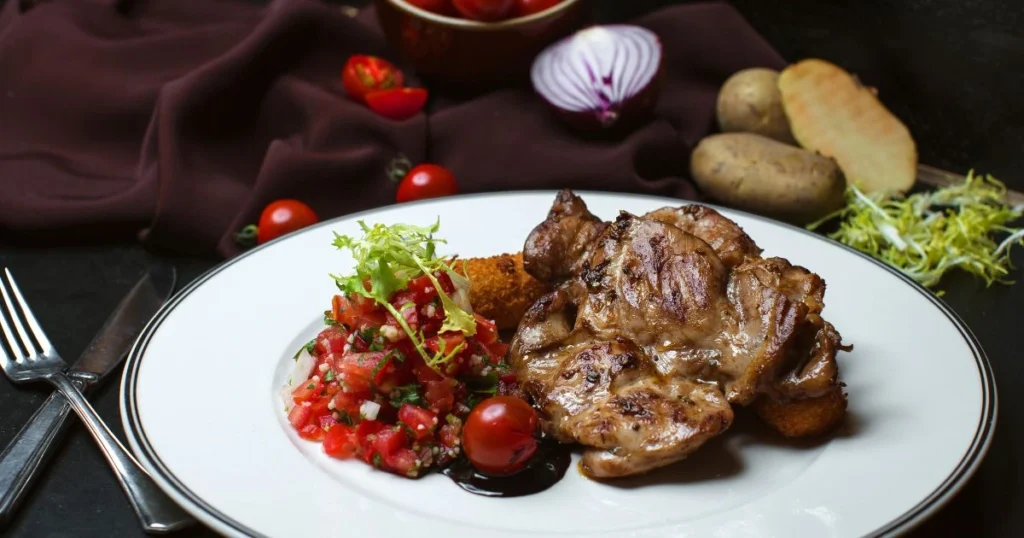
Creating a great lamb breast recipe begins with the right ingredients. Your choice of lamb breast seasoning can turn a simple cut into a masterpiece. It’s all about picking the right parts to bring out the meat’s natural taste and make your meal unforgettable.
- High-quality extra virgin olive oil
- Fresh herbs like rosemary, thyme, and parsley
- Robust spices including paprika, garlic powder, and cumin
- Coarse sea salt and freshly ground black pepper
Mediterranean-style lamb seasoning mixes aromatic herbs with strong spices. You aim to make a mix that boosts the meat’s flavor without drowning it.
| Ingredient Category | Recommended Options | Flavor Profile |
|---|---|---|
| Herbs | Rosemary, Thyme, Oregano | Earthy, Aromatic |
| Spices | Paprika, Cumin, Garlic Powder | Warm, Intense |
| Liquid Base | Extra Virgin Olive Oil | Smooth, Rich |
Pro tip: Always choose fresh ingredients for the best lamb seasoning. High-quality ingredients make a big difference in flavor.
Preparing Your Lamb Breast Plate Recipe
Preparing a delicious lamb breast plate is all about careful preparation and the right techniques. Whether you’re a home cook or a culinary enthusiast, mastering the split lamb breast plate recipe starts with understanding the key preparation steps.
Before you start cooking, set up your kitchen and prepare the meat with precision. Proper preparation ensures tender, flavorful results that will impress your dinner guests.
Trimming and Cleaning the Meat
When working with lamb breast, careful trimming is key for optimal flavor and texture. Follow these essential steps for preparing your meat:
- Remove excess fat using a sharp knife
- Carefully lift the translucent membrane covering the ribs
- Use paper towels to grip the membrane for easy removal
- Rinse the meat thoroughly under cold water
- Pat dry with clean paper towels
Seasoning and Marination Tips
Lamb breast cooking methods rely heavily on proper seasoning. Create a robust flavor profile with these marination strategies:
- Use kosher salt and freshly ground black pepper as base seasonings
- Consider Mediterranean-inspired herb blends
- Allow marination for at least 2-4 hours before cooking
- Use olive oil to help herbs and spices adhere to the meat
Equipment Needed
| Equipment | Purpose |
|---|---|
| Roasting Pan | Even heat distribution |
| Sharp Boning Knife | Precise meat trimming |
| Meat Thermometer | Ensure proper internal temperature |
| Large Mixing Bowl | Marinating the lamb breast |
By following these preparation guidelines, you’ll be well on your way to creating a mouthwatering lamb breast plate that showcases your culinary skills.
Cooking Methods for Tender Results
Exploring the best ways to cook lamb breast can change your cooking game. Grilling lamb needs special techniques for a juicy and tasty dish. Each method brings out different qualities in the meat, making your dishes taste like they’re from a restaurant.
When you’re into bbq lamb, remember these key cooking techniques:
- Slow Roasting: The best way to get meat that falls off the bone
- Braising: Great for making tough meat tender
- Grilling: Perfect for a crispy outside with smoky taste
- Barbecue: Great for slow cooking with rich flavors
Cook lamb in a way that keeps it juicy and full of flavor. Slow cooking at low temperatures tenderizes the meat. Grilling lamb works best with indirect heat and checking the meat’s internal temperature.
Pro tip: Resting lamb for 10–15 minutes helps retain moisture and enhances tenderness.
For those who love bbq lamb, marinating the meat before cooking can really boost flavor and texture. Acidic ingredients such as lemon juice or vinegar tenderize meat by breaking down its proteins.
Mediterranean-Style Lamb Breast Seasoning
Take your lamb dishes to the next level with Mediterranean-style seasoning. The right mix of herbs and spices can make a simple cut of meat into a feast for the senses.
Creating the perfect seasoning for lamb breast is all about finding the right balance. Mediterranean flavors are rich and aromatic, making them perfect for lamb.
Classic Herb Combinations
Your seasoning should include classic Mediterranean herbs for depth and complexity:
- Fresh rosemary – adds an earthy, pine-like flavor
- Dried oregano – brings a robust, slightly bitter taste
- Thyme leaves – adds a subtle, minty flavor
- Crushed garlic – gives a strong, pungent taste
Creating the Perfect Rub
The secret to a great seasoning is a balanced dry rub that gets into the meat. Here’s a classic blend:
- 2 tablespoons dried herbs (mix of rosemary, thyme, oregano)
- 1 tablespoon sea salt
- 1 teaspoon black pepper
- 2 minced garlic cloves
- 1 tablespoon extra virgin olive oil
For more flavor, try a wet marinade with kalamata olives, Italian parsley, and lemon juice. This will turn your lamb into a gourmet dish that wows everyone.
Step-by-Step Roasting Guide
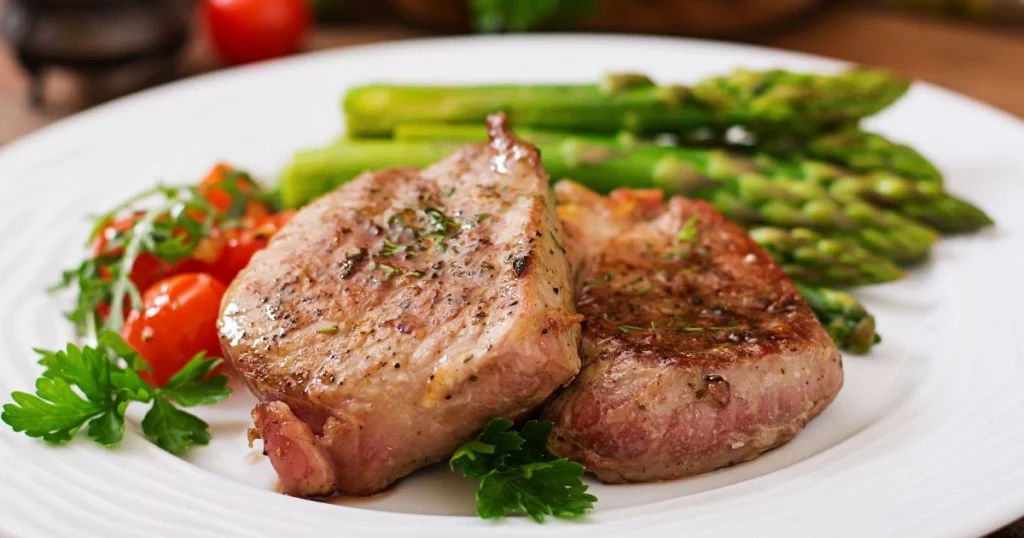
Roasting lamb breast needs precision and care for a tender and flavorful dish. When making your lamb breast plate recipe, follow these essential steps for success.
Begin by taking the lamb out of the fridge 30-45 minutes before cooking. This step is key. Allowing the meat to reach room temperature ensures even cooking and helps keep it tender in your lamb recipes.
- Preheat your oven to 325°F (165°C)
- Select a deep roasting pan with a tight-fitting lid
- Place the lamb breast with the fat side facing up
- Season generously with your prepared herb rub
Cooking lamb needs careful attention. Place aluminum foil or a lid over the roasting pan. This keeps moisture in and prevents the meat from drying out.
| Cooking Stage | Temperature | Time |
|---|---|---|
| Initial Roasting | 325°F | 1.5 hours |
| Uncovered Finishing | 375°F | 30 minutes |
For the best results, use a meat thermometer. The ideal temperature for lamb breast is 145°F (63°C) for medium-rare. Once cooked, allow the meat to rest for 10–15 minutes. This allows juices to spread evenly.
“Patience and exact temperature control are the keys to perfect lamb.” — Professional Chef
Your lamb breast plate recipe is now ready to impress with its rich flavor and succulent texture.
Temperature and Timing Guidelines
Mastering cooking lamb is all about getting the temperature and timing right. The way you cook your lamb breast can turn a tough, dry piece of meat into a tender, juicy dish. Knowing the right internal temperatures and how to rest the meat will take your cooking to the next level.
Getting the perfect lamb breast is all about monitoring the temperature and resting it right. Each level of doneness needs a specific internal temperature. This ensures the meat is both safe to eat and full of flavor.
Internal Temperature Requirements
Use a meat thermometer to check the lamb’s internal temperature accurately. Here are the recommended temperatures for lamb breast:
- Rare: 125°F (52°C)
- Medium-Rare: 135°F (57°C)
- Medium: 145°F (63°C)
- Well-Done: 160°F (71°C)
The Critical Resting Period
After taking the lamb breast off the heat, let it rest for 20-30 minutes. This step is key. It lets the meat’s juices spread out, making it moist and tender.
| Lamb Weight | Cooking Time | Resting Time |
|---|---|---|
| 2-3 lbs | 1.5-2 hours | 20-25 minutes |
| 3-4 lbs | 2-2.5 hours | 25-30 minutes |
Pro tip: Cover the lamb breast loosely with foil during resting. This helps maintain warmth while preventing excess steam buildup. It helps keep the meat’s crispy outside while keeping it juicy inside.
Complementary Side Dishes and Pairings
Picking the perfect side dishes can elevate your lamb recipes. Lamb breast has a rich flavor that needs the right sides to balance it. These sides should enhance its unique taste.
When picking sides for your lamb, look for ones that match its bold flavor. Roasted vegetables are a great choice to balance the lamb’s fatty taste. Here are some top picks:
- Garlic-roasted baby potatoes
- Herb-infused Mediterranean vegetable medley
- Minted green pea puree
- Quinoa salad with fresh herbs
Wine pairings can take your lamb dish to a new level. Red wines pair well with lamb’s strong taste. Here are some great wine choices:
- Cabernet Sauvignon
- Syrah/Shiraz
- Malbec
“The right side dish doesn’t just accompany lamb—it completes the culinary story.” – Chef Michael Romano
To make a balanced meal, mix textures and flavors. Choose crisp, bright sides to cut through the lamb’s richness. This will make your meal memorable and show off your cooking skills.
Storage and Reheating Tips
Keeping your lamb breast plate recipe delicious means storing and reheating it right. After you’ve enjoyed your dish, you’ll want to keep the meat tasty and fresh.
Here’s how to store leftover lamb breast:
- Use an airtight container to prevent moisture loss
- Refrigerate within two hours of cooking
- Store in the refrigerator for up to 4 days
- Wrap tightly in plastic wrap or aluminum foil
To reheat your lamb breast plate, use an oven. This method keeps the meat tender. Warming it slowly is crucial to keep it from drying out.
| Reheating Method | Temperature | Recommended Time |
|---|---|---|
| Oven | 300°F | 15-20 minutes |
| Microwave | 50% power | 1-2 minutes |
| Stovetop | Low heat | 5-7 minutes |
For longer storage, freeze your lamb breast plate for up to three months. Wrap the meat in freezer-safe packaging, removing as much air as possible to prevent freezer burn.
Pro tip: Turn leftover lamb into new dishes like sandwiches, salads, or pasta. This way, you can enjoy your meal longer and reduce waste.
Conclusion
Your journey through creating gourmet lamb dishes doesn’t end here. The lamb breast plate recipe you’ve learned is a delicious culinary adventure. It transforms a basic cut of meat into a remarkable dish.
By understanding the nuances of preparation, seasoning, and cooking techniques, you can elevate this protein from ordinary to exceptional. Experimenting with different herbs, spices, and cooking methods will help you develop your unique approach to lamb breast dishes.
Each time you prepare this cut, you’ll gain more confidence in your cooking skills. Keep in mind: patience and precision are essential for tender, flavorful results. These results will impress your family and guests.
Lamb breast’s versatility lets you experiment with diverse cuisines and flavor combinations. Whether you’re preparing a casual weeknight dinner or planning a special occasion meal, this cut offers endless possibilities. Embrace the learning process, and don’t be afraid to adapt recipes to suit your personal taste preferences.
By applying the techniques and insights shared in this guide, you’ll be well-equipped to create stunning gourmet lamb dishes. These dishes will showcase the rich, complex flavors of lamb breast. Your culinary skills will continue to grow with each delicious preparation.

